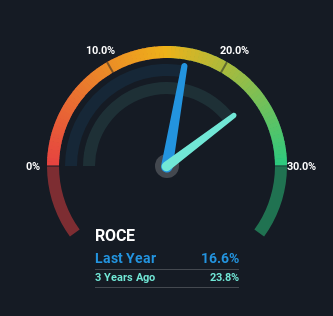
To find a multi-bagger stock, what are the underlying trends we should look for in a business? Firstly, we'll want to see a proven return on capital employed (ROCE) that is increasing, and secondly, an expanding base of capital employed. Basically this means that a company has profitable initiatives that it can continue to reinvest in, which is a trait of a compounding machine. So, when we ran our eye over Ocean One Holding's (HKG:8476) trend of ROCE, we liked what we saw.
We check all companies for important risks. See what we found for Ocean One Holding in our free report.What Is Return On Capital Employed (ROCE)?
Just to clarify if you're unsure, ROCE is a metric for evaluating how much pre-tax income (in percentage terms) a company earns on the capital invested in its business. Analysts use this formula to calculate it for Ocean One Holding:
Return on Capital Employed = Earnings Before Interest and Tax (EBIT) ÷ (Total Assets - Current Liabilities)
0.17 = HK$45m ÷ (HK$287m - HK$16m) (Based on the trailing twelve months to September 2024).
Therefore, Ocean One Holding has an ROCE of 17%. On its own, that's a standard return, however it's much better than the 8.7% generated by the Consumer Retailing industry.
Check out our latest analysis for Ocean One Holding

Historical performance is a great place to start when researching a stock so above you can see the gauge for Ocean One Holding's ROCE against it's prior returns. If you're interested in investigating Ocean One Holding's past further, check out this free graph covering Ocean One Holding's past earnings, revenue and cash flow.
What Does the ROCE Trend For Ocean One Holding Tell Us?
While the current returns on capital are decent, they haven't changed much. The company has employed 110% more capital in the last five years, and the returns on that capital have remained stable at 17%. 17% is a pretty standard return, and it provides some comfort knowing that Ocean One Holding has consistently earned this amount. Stable returns in this ballpark can be unexciting, but if they can be maintained over the long run, they often provide nice rewards to shareholders.
On a side note, Ocean One Holding has done well to reduce current liabilities to 5.6% of total assets over the last five years. This can eliminate some of the risks inherent in the operations because the business has less outstanding obligations to their suppliers and or short-term creditors than they did previously.
The Key Takeaway
To sum it up, Ocean One Holding has simply been reinvesting capital steadily, at those decent rates of return. On top of that, the stock has rewarded shareholders with a remarkable 437% return to those who've held over the last five years. So even though the stock might be more "expensive" than it was before, we think the strong fundamentals warrant this stock for further research.
If you're still interested in Ocean One Holding it's worth checking out our FREE intrinsic value approximation for 8476 to see if it's trading at an attractive price in other respects.
While Ocean One Holding may not currently earn the highest returns, we've compiled a list of companies that currently earn more than 25% return on equity. Check out this free list here.
Have feedback on this article? Concerned about the content? Get in touch with us directly. Alternatively, email editorial-team (at) simplywallst.com.
This article by Simply Wall St is general in nature. We provide commentary based on historical data and analyst forecasts only using an unbiased methodology and our articles are not intended to be financial advice. It does not constitute a recommendation to buy or sell any stock, and does not take account of your objectives, or your financial situation. We aim to bring you long-term focused analysis driven by fundamental data. Note that our analysis may not factor in the latest price-sensitive company announcements or qualitative material. Simply Wall St has no position in any stocks mentioned.